Roy Thomas' All-Star Squadron-A trip back in Time (Reviews)
Sept 16, 2020 16:17:10 GMT -5
dbutler69 and brutalis like this
Post by codystarbuck on Sept 16, 2020 16:17:10 GMT -5
All-Star squadron #39

Creative Team: Roy Thomas-writer/editor, Rick Hoberg-pencils, Bill Collins-inks, Cody Weiss-letters, Gene D'Angelo-colors
Synopsis: It's 5:00 am in Detroit and the All-Stars stop in at a diner for the daily intake of fat and grease and a bit of intel...
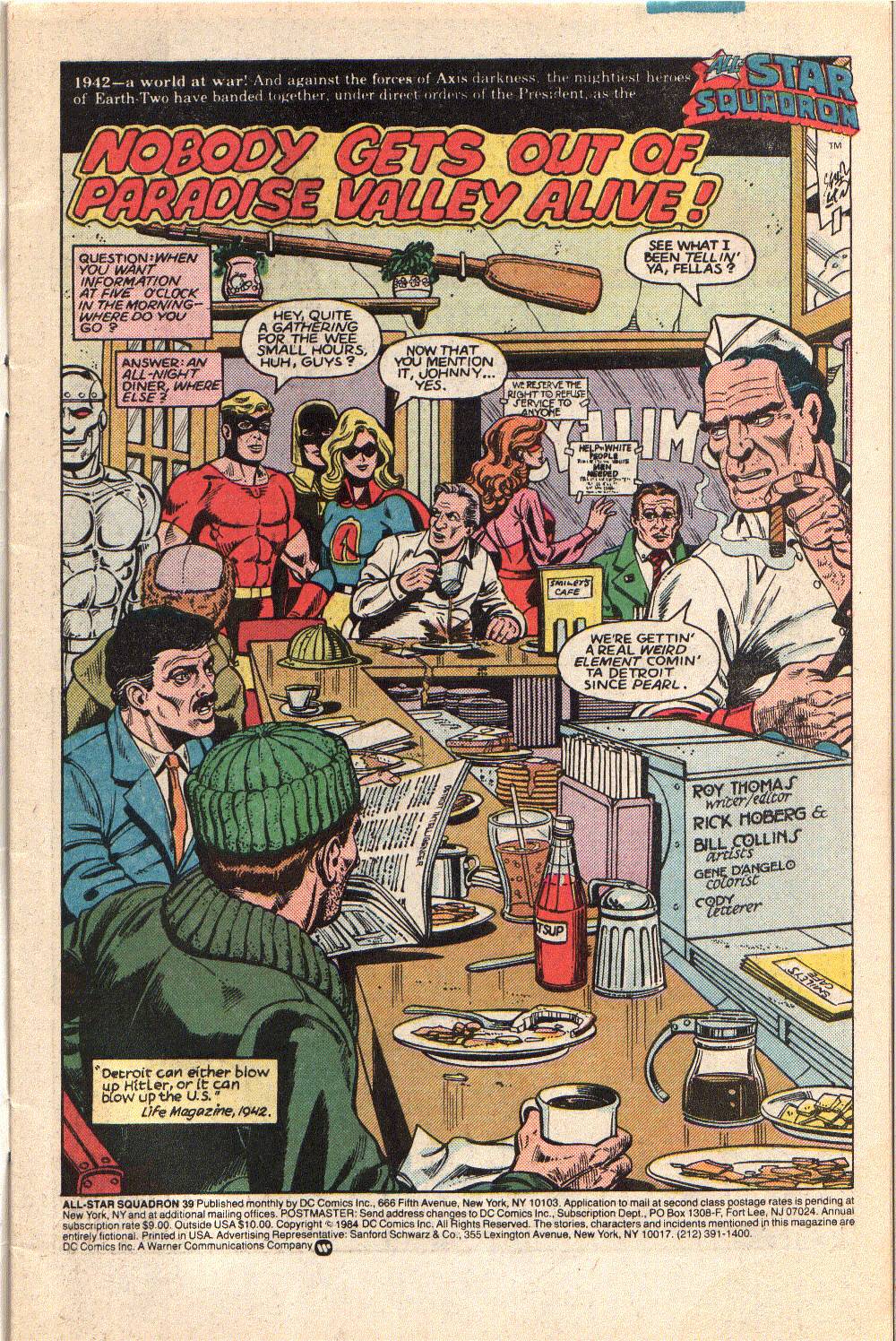
Based on the guy at the counter, I think you could sue the diner for false advertising...
Smiley ain't talking and the others are also quiet; but, Firebrand finds a notice about white people being needed and asks for directions. A moron tries to manhandle her (she's got flaming hands, dude...let it lie) and Robotman immediately lets him know he should let her go and provide directions, or suffer crushed bones in his hand. he complies and they leave, though the dude with the sore hand calls them N-lovers, and no I don't mean Neopolitan ice cream. DC actually let Roy use the N-word, in context, in a story about race relations in 1942. The New DC indeed!
Hourman stole a page from the phone book, to try to locate Will Everett. They split up to search. Roy runs down the backhistory of the northward migration of Southerners, particularly African-Americans, in search of jobs in the auto industry (which was defense work).

Meanwhile, the Phantom Empire are holding their rally, with Real American, aka Kaptain Klux Klan. He agitates and then uses his steel whip to attack a dissenting voice and he gets the bum's rush. RA then leads the mob off to rouse some rabble. Firebrand stops to speed up their fiery cross to remove it and they follow.
Meanwhile, Johnny and Libby hit paydirt, when they find Will Everett's fiance, who begged him to stay out of things. Also inside is Will's mother. Will and his father have gone to move them into the Sojourner Truth Homes and they fear violence. Johnny thinks they can handle things and Rachel unloads a century's worth of anger and frustration on him, in a page ripped from the headlines...
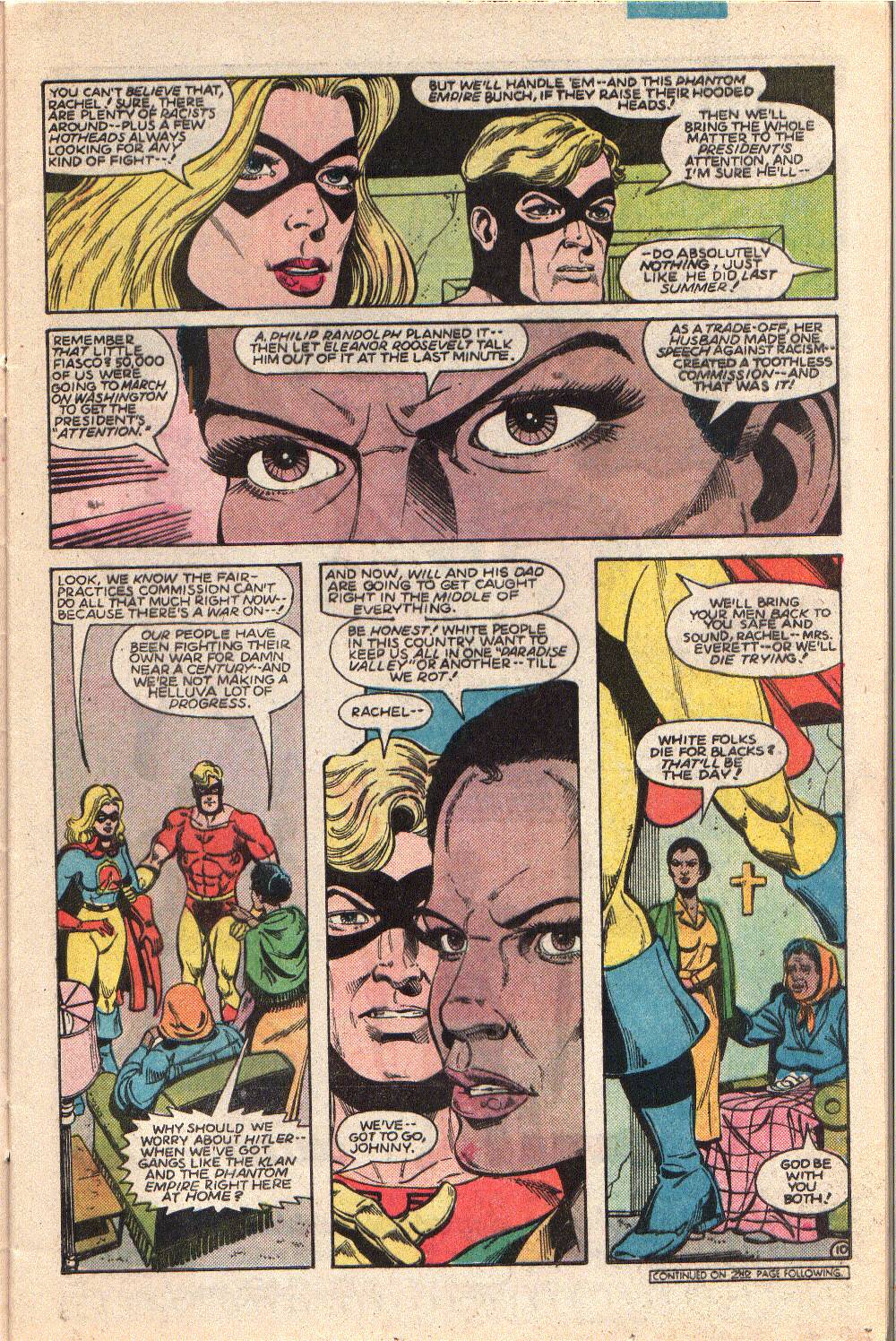
At 9:30, Johnny and Libby are there at the scene, in their civilian identities as journalists (newsreel camerman and reporter) and some of the crowd is threatening that they better tell the story "right." A woman calls Libby a communist, when she defends the rights of people to live where they chose.
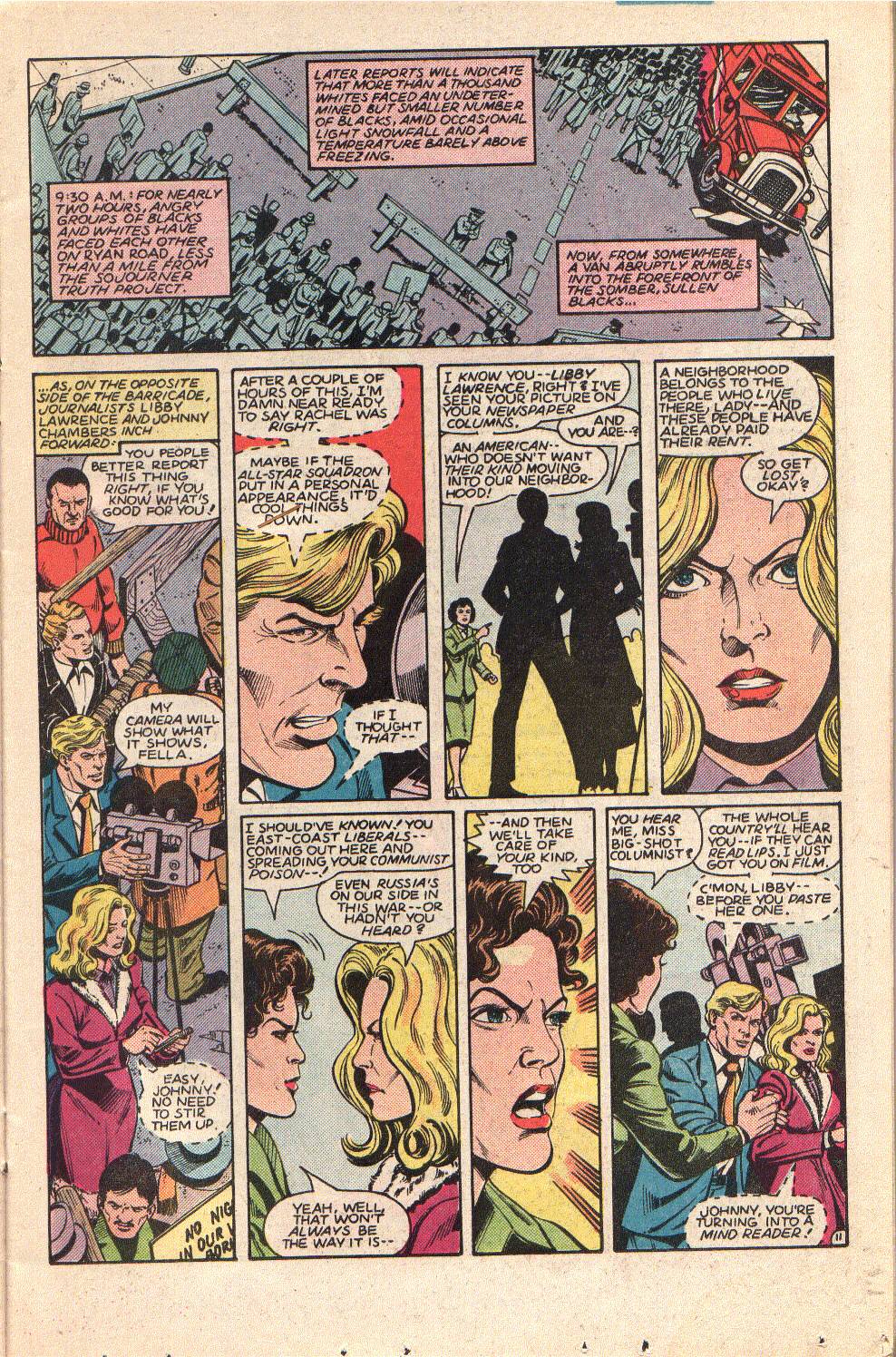
Jake Everett decides to ignore the mob and brings his truck up to unload and gets a brick through the window. Will springs into action, as Amazing Man. Someone throws a brick at him and he hits them with a man of brick. The All-Stars spring into action to try to separate the mob and cool things down and Libby notices the police seem to be treating some people in the crowd differently than others...
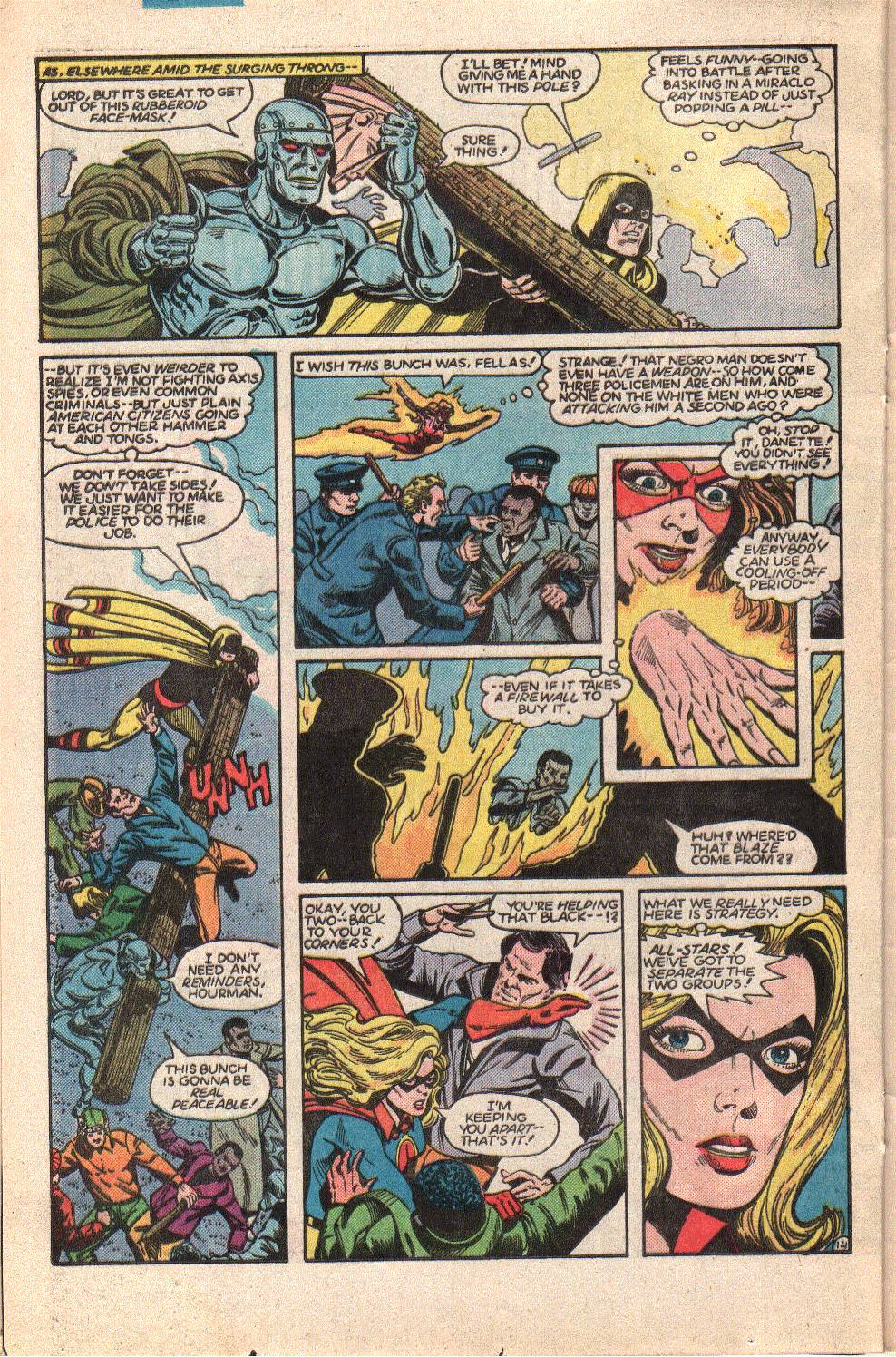
Libby coordinates their actions and Johnny scoops up missiles, while Hourman and Firebrand create crowd barriers. Then Real American turns up. Amazing Man responds and they battle and RA proves strong enough to knock AM around. He transmutes to steel, but RA still overpowers him. Johnny tries to talk Will down, to stop the fighting; but, Will is angry and takes a shot at Johnny, who ducks, then he is hit, unaware, by a thrown brick and knocked out. The cops hau l him in, while Real American continues to spout bile and spittle. Jake confronts the All-Stars, but Libby still believes the law is applied equally and Jake said he tried peacefully; now all bets are off.
At the White House, GL and Hawkman appeal to FDR, who says he won't intervene in a "local matter." The pair shake their heads and head off for Detroit.
The letters page has another reminiscence from Mart Nodell, about the birth of Green Lantern.
There is a page devoted to All-Star Comics revival of the Junior JSA fan club.
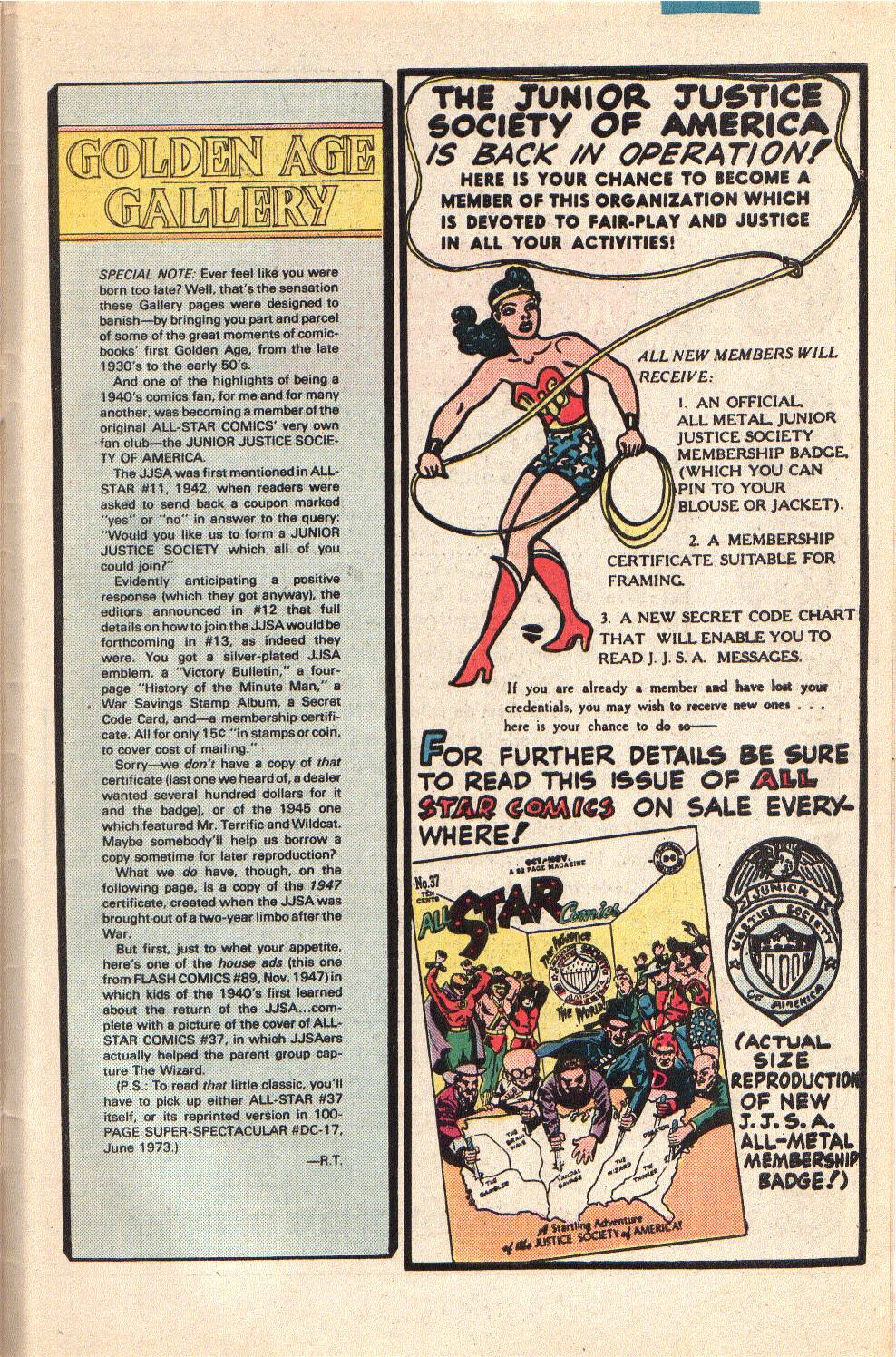
There is also a reproduction of the membership certificate, signed by JSA secretary Diana Prince.
Thoughts: Roy's doing a lot of educating in this one, as the basic plot mirrors the events of the rioting surrounding the opening of the Sojourner Truth Homes, in Detroit, in Feb 1942. In so doing, he illustrates how the war didn't suddenly solve all of America's problems, but shifted some of them into new venues. He also pretty accurately reflects varying viewpoints of those involved, from whites who feared an influx of outsiders, particularly blacks, to the anger of African-Americans, who have dealt with laws twisted against them of not enforced, since Emancipation. Libby gives voice to idealists who faced harsh realities when they saw the law was applied equally to all citizens. He argument with the woman shows that Communists were still seen as the enemy of the Right and that battle was just simmering while the war went on. That same conflict played out across the globe, as conservative and leftist resistance groups clashed with each other as much as with the Nazis, with wholescale civil wars fought after the war ended.
The action is a bit subdued here and we get a glimpse of how useless superheroes are as a metaphor for anything other than vigilante justice. They are unable to solve social problems, other than to shine a light on them, usually in well-meaning but heavy handed stories. Roy is walking a tightrope but hasn't slipped into Denny O'Neil muckraking, nor has he been Stan Lee fence straddling. He's letting history's example teach us and help us shape our own mind bout the situation and apply it to today's issues. I doubt, though, he thought it would still be so pertinent. America sure seems to ignore Santayana far too often. Then again, so does much of the rest of the world.
Hoberg and Collins continue to do fine, if not breathtaking work. They are good storytellers, which is what is needed most, especially with history at the core of the book.
Real American proves to be more than a guy under a hood; so, we have that mystery to solve, as we conclude things next issue.
Historical Notes: Rachel mentions A (Asa) Phillip Randolph. he was the organizer and leader of the Brotherhood of Sleeping Car Porters, the first African-American labor union (organizing against the Pullman company) and a pioneer in the Civil Rights movement. His work, along with allies and supporters, led to Executive Order 8802, banning discrimination in the defense industries, in 1941 and EO 9981, in 1948, which ended racial segregation in the US Armed Forces. Randolph and a group of organizers were planning a march on Washington, in 1941, to protest segregation and other grievances, when EO 8802 took some wind out of their sails, while Eleanor Roosevelt met with Randolph to persuade them not to march, that the president was going to address their concerns. FDR made a speech condemning racism, but, refused to get involved in the Detroit situation and was seen in some corners as being patronizing for votes, but unwilling to lead on the issue. In all probability, FDR was probably keeping silent to appease Southern Democrats, for fear of them crossing over to the republican side, which is what eventually happened, in the wake of desegregation and other Federal interventions. Randolph was also involved in successful labor action in 1944, to gain equal pay for black defense workers in the Philadelphia Transit Strike of 1944. These successes, and the desegregation of the military, plus the history of service for African-American veterans formed the nucleus of what would become the Civil Rights Movement. Randolph employed the methods of Mohandas Gandhi, in the battles for Indian independence, as well as his work in South Africa. He advocated Gandhi's non-violent resistance method, which became the foundation of the movement.
Randolph was heavily involved in the Civil Rights Movement and its major milestones and was at the head of the March on Washington, where Martin Luther King delivered his "I Have a dream" speech. In 1964, he was awarded the Presidential Medal of Freedom, by Lyndon Johnson, the highest civilian award of the nation. He died in 1979.
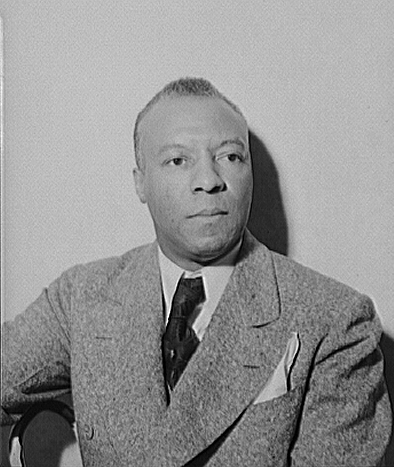

December 1942
The US has been at war for one year. Great Britain and Germany for 3 years, and Japan and China, formally, since 1937; and, in effect, for 10 years, since the invasion of Manchuria, in 1931.
Gasoline rationing in the US begins.
On Dec 2, underneath the bleachers of Stagg Field, at the Univ of Chicago, Enrico Fermi supervises the first sustained nuclear chain reaction, initiated by man. A coded message is sent to the White House, indicating success of the experiment. The Nuclear Age begins. From here, the Manhattan Project, under Robert Oppenheimer and Gen Leslie Groves, will develop two bombs, which will be used against the cities of Hiroshima and Nagasaki, unleashing nuclear destruction on mankind. Debate has raged ever since about the cost in human lives vs the likely cost in lives from an invasion of the Japanese home islands.
Royal Marine commandos carry out Operation Frankfort, a sabotage mission directed against German shipping, at the port of Bordeaux. The plan called for 12 men to deploy in 2-man kayaks, from a submarine, at the Gironde estuary and navigate up the river to the port. They would then attach limpet mines to ships and then escape overland to Spain, with the aid of the Maquis. One kaya was damaged and could not participate, leaving 10 men for the raid. Because of weight limitations in the kayaks, the only weapons carried by the men were M1911 Colt automatic pistols and Sykes-Fairbairn fighting knives, as well as two grenades, the limpit mines and tools and kayak equipment. They had to paddle 10 miles to the mouth of the estuary and get past a checkpoint. Their journey would cover two nights and the laid up in hiding, during the day. Of the 5 deployed, one capsized and was scuttled, with its team towed until they could swim for shore, where they met up with a missing kayak, that had become separated from the other 3. One of the kayak's became separated from the group and had to land and escape, though the team was betrayed and arrested by the gendarmes and turned over to the Gestapo, after 4 days. After a lay-up, another team was captured near the lighthouse, where they hid. Only two kayaks made it to the harbor and carried out the mining operations, attaching mines to 9 ships and evacuated, after raising an alarm on a patrol boat. The kayaks moved out separately; but met up again, by chance. One team was captured 2 days later; but, the other, with CO Major Herbert Hassler, made contact with the Resistance, hid for 18 days, then were taken across the Pyranees, on foot, into Spain. All 10 men had been listed as lost, until word reached them of Hassler and Marine Bill Sparks, his team partner. The captured men were executed under Hitler's Commando Order. The two men whose kayak capsized made it to shore, but died of hypothermia.
The men became known as the "Cockleshell Heroes" after the nickname for the Mark II kayaks. Their story was dramatized in the 1955 film, starring Jose Ferrer, Trevor Howard and Anthony Newley (yes, as a Marine), with ferrer directing. The film was produced by Irving Allen and Cubby Broccoli's Warwick Films and also features Christopher Lee in a small role. Lee served with RAF intelligence, in North Africa, with various stories and rumors of his duties. he later served in the Italian theater and was part of a group that hunted Nazi war criminal suspects, during his final months int he service. The film is basically an action adventure, in thwe usual commando raid mode (small band sneaking in and creating havoc, then going on the run) and it is pretty gung ho and balderdized; but, it does address a few issues that many war films ignored, such as one Marine whose wife is carrying on an affair with a civilian man. The Marine goes AWOL to confront his wife and beats the everloving crap out of the man, while the XO covers for him with the Marines and the police. It's a pretty good film and also carries some lessons in leadership, as Ferrer's CO tries unconventional training methods that backfire and the XO, a regular Marine, has to teach him how to instill discipline in the team and get them to walk through fire to accomplish their mission.
The Germans launch Operation Winter Storm in an effort to rescue the encircled forces near Stalingrad. The fighting progressed over 10 days, with great gains by the Germans on the first day of the offensive, but Russian resistance slowed them and the German's eventually had to pull back, leaving the surrounded forces trapped, with Hitler refusing to extract them.
On Guadalcanal, the fighting reached its finals stages, as the US launched an offensive to capture Japanese defensive positions in areas known as Moutn Austen, the Galloping Horse and the Sea Horse. Fighting lasted from Dec 15 until February, 1943. The Japanese were cut off from resupply and were malnourished and fighting malaria and other medical problems. The US forces were inexperienced, with most entering their first battle. Fighting was intense,but US troops were reinforced in January, with the Army 25th Division and the Marine 2nd Division. The US was able to capture positions on Mount Austen, which weakened the defenses of the others. The Japanese ordered a withdrawal of their troops, with those unable to pull back to fight to the death. The US learned of their operations, but misinterpreted it as another resupply attempt and reacted swiftly, which caused the Japanese to speed up the withdrawal. Rear guard units fought ferociously and most died in the fighting, but, the Japanese succeeded in evacuating over 10,000 troops. By February, Guadalcanal was in US hands and it became a staging point for further operations.
In Warsaw, Zofia Kossak and Wanda Filipowicz formed the secret Council for the Assistance of Jews. Jews were denied all rights and Poles were under harsh orders not to aid them, under severe penalty. Some obeyed and some actively collaborated in the holocaust; but, others provided assistance. In response, the Germans massacred 5 families who provided aid to Jews. Reports were smuggled out to the Polish government-in-exile and they prepared the brochure The Mass extermination of Jews in German Occupied Poland. A particular part of it was a note from Foreign Minister Edward Raczynski, detailing German mass shootings and the gassing of Jews. The material was distributed to the governments of the United nations, outlining the German actions of the Holocaust. It appeared on the front page of the New York Times and Foreign Minister Anthony Eden read it out in Parliament. In response, the UN issued the Joint Declaration by members of the United Nations, which described the events of the Holocaust, as they had been detailed. This was the first public acknowledgment of German actions in the occupied territories. The report was met with skepticism in many corners, as people found it hard to believe the Germans could commit such atrocities. They would come to see and accept the truth, with the liberation of the concentration camps, with the horrifying images of the survivors, the mounds of dead bodies and the captured records of the exterminations. French filmmaker Alan Resnais, in 1956, would produce the documentary Night and Fog, which used captured SS footage, Allied footage after liberation, stills, and other documents to chronicle the inhuman actions that were carried out. I watched this film, when I was in my 40s, well steeped in WW2 history and images of the Holocaust; yet found the images to be stomach churning that any human being was capable of such depraved acts of violence and terror. You feel like you want to turn away from things; but you can't and you also feel like it is your duty to those murdered to bear witness to what happened.
At times Square, on New Years Eve, the lighted ball was not dropped. Instead, a moment of silence was held, followed by the ringing of bells, from sound trucks.

Creative Team: Roy Thomas-writer/editor, Rick Hoberg-pencils, Bill Collins-inks, Cody Weiss-letters, Gene D'Angelo-colors
Synopsis: It's 5:00 am in Detroit and the All-Stars stop in at a diner for the daily intake of fat and grease and a bit of intel...
Based on the guy at the counter, I think you could sue the diner for false advertising...
Smiley ain't talking and the others are also quiet; but, Firebrand finds a notice about white people being needed and asks for directions. A moron tries to manhandle her (she's got flaming hands, dude...let it lie) and Robotman immediately lets him know he should let her go and provide directions, or suffer crushed bones in his hand. he complies and they leave, though the dude with the sore hand calls them N-lovers, and no I don't mean Neopolitan ice cream. DC actually let Roy use the N-word, in context, in a story about race relations in 1942. The New DC indeed!
Hourman stole a page from the phone book, to try to locate Will Everett. They split up to search. Roy runs down the backhistory of the northward migration of Southerners, particularly African-Americans, in search of jobs in the auto industry (which was defense work).
Meanwhile, the Phantom Empire are holding their rally, with Real American, aka Kaptain Klux Klan. He agitates and then uses his steel whip to attack a dissenting voice and he gets the bum's rush. RA then leads the mob off to rouse some rabble. Firebrand stops to speed up their fiery cross to remove it and they follow.
Meanwhile, Johnny and Libby hit paydirt, when they find Will Everett's fiance, who begged him to stay out of things. Also inside is Will's mother. Will and his father have gone to move them into the Sojourner Truth Homes and they fear violence. Johnny thinks they can handle things and Rachel unloads a century's worth of anger and frustration on him, in a page ripped from the headlines...
At 9:30, Johnny and Libby are there at the scene, in their civilian identities as journalists (newsreel camerman and reporter) and some of the crowd is threatening that they better tell the story "right." A woman calls Libby a communist, when she defends the rights of people to live where they chose.
Jake Everett decides to ignore the mob and brings his truck up to unload and gets a brick through the window. Will springs into action, as Amazing Man. Someone throws a brick at him and he hits them with a man of brick. The All-Stars spring into action to try to separate the mob and cool things down and Libby notices the police seem to be treating some people in the crowd differently than others...
Libby coordinates their actions and Johnny scoops up missiles, while Hourman and Firebrand create crowd barriers. Then Real American turns up. Amazing Man responds and they battle and RA proves strong enough to knock AM around. He transmutes to steel, but RA still overpowers him. Johnny tries to talk Will down, to stop the fighting; but, Will is angry and takes a shot at Johnny, who ducks, then he is hit, unaware, by a thrown brick and knocked out. The cops hau l him in, while Real American continues to spout bile and spittle. Jake confronts the All-Stars, but Libby still believes the law is applied equally and Jake said he tried peacefully; now all bets are off.
At the White House, GL and Hawkman appeal to FDR, who says he won't intervene in a "local matter." The pair shake their heads and head off for Detroit.
The letters page has another reminiscence from Mart Nodell, about the birth of Green Lantern.
There is a page devoted to All-Star Comics revival of the Junior JSA fan club.
There is also a reproduction of the membership certificate, signed by JSA secretary Diana Prince.
Thoughts: Roy's doing a lot of educating in this one, as the basic plot mirrors the events of the rioting surrounding the opening of the Sojourner Truth Homes, in Detroit, in Feb 1942. In so doing, he illustrates how the war didn't suddenly solve all of America's problems, but shifted some of them into new venues. He also pretty accurately reflects varying viewpoints of those involved, from whites who feared an influx of outsiders, particularly blacks, to the anger of African-Americans, who have dealt with laws twisted against them of not enforced, since Emancipation. Libby gives voice to idealists who faced harsh realities when they saw the law was applied equally to all citizens. He argument with the woman shows that Communists were still seen as the enemy of the Right and that battle was just simmering while the war went on. That same conflict played out across the globe, as conservative and leftist resistance groups clashed with each other as much as with the Nazis, with wholescale civil wars fought after the war ended.
The action is a bit subdued here and we get a glimpse of how useless superheroes are as a metaphor for anything other than vigilante justice. They are unable to solve social problems, other than to shine a light on them, usually in well-meaning but heavy handed stories. Roy is walking a tightrope but hasn't slipped into Denny O'Neil muckraking, nor has he been Stan Lee fence straddling. He's letting history's example teach us and help us shape our own mind bout the situation and apply it to today's issues. I doubt, though, he thought it would still be so pertinent. America sure seems to ignore Santayana far too often. Then again, so does much of the rest of the world.
Hoberg and Collins continue to do fine, if not breathtaking work. They are good storytellers, which is what is needed most, especially with history at the core of the book.
Real American proves to be more than a guy under a hood; so, we have that mystery to solve, as we conclude things next issue.
Historical Notes: Rachel mentions A (Asa) Phillip Randolph. he was the organizer and leader of the Brotherhood of Sleeping Car Porters, the first African-American labor union (organizing against the Pullman company) and a pioneer in the Civil Rights movement. His work, along with allies and supporters, led to Executive Order 8802, banning discrimination in the defense industries, in 1941 and EO 9981, in 1948, which ended racial segregation in the US Armed Forces. Randolph and a group of organizers were planning a march on Washington, in 1941, to protest segregation and other grievances, when EO 8802 took some wind out of their sails, while Eleanor Roosevelt met with Randolph to persuade them not to march, that the president was going to address their concerns. FDR made a speech condemning racism, but, refused to get involved in the Detroit situation and was seen in some corners as being patronizing for votes, but unwilling to lead on the issue. In all probability, FDR was probably keeping silent to appease Southern Democrats, for fear of them crossing over to the republican side, which is what eventually happened, in the wake of desegregation and other Federal interventions. Randolph was also involved in successful labor action in 1944, to gain equal pay for black defense workers in the Philadelphia Transit Strike of 1944. These successes, and the desegregation of the military, plus the history of service for African-American veterans formed the nucleus of what would become the Civil Rights Movement. Randolph employed the methods of Mohandas Gandhi, in the battles for Indian independence, as well as his work in South Africa. He advocated Gandhi's non-violent resistance method, which became the foundation of the movement.
Randolph was heavily involved in the Civil Rights Movement and its major milestones and was at the head of the March on Washington, where Martin Luther King delivered his "I Have a dream" speech. In 1964, he was awarded the Presidential Medal of Freedom, by Lyndon Johnson, the highest civilian award of the nation. He died in 1979.


December 1942
The US has been at war for one year. Great Britain and Germany for 3 years, and Japan and China, formally, since 1937; and, in effect, for 10 years, since the invasion of Manchuria, in 1931.
Gasoline rationing in the US begins.
On Dec 2, underneath the bleachers of Stagg Field, at the Univ of Chicago, Enrico Fermi supervises the first sustained nuclear chain reaction, initiated by man. A coded message is sent to the White House, indicating success of the experiment. The Nuclear Age begins. From here, the Manhattan Project, under Robert Oppenheimer and Gen Leslie Groves, will develop two bombs, which will be used against the cities of Hiroshima and Nagasaki, unleashing nuclear destruction on mankind. Debate has raged ever since about the cost in human lives vs the likely cost in lives from an invasion of the Japanese home islands.
Royal Marine commandos carry out Operation Frankfort, a sabotage mission directed against German shipping, at the port of Bordeaux. The plan called for 12 men to deploy in 2-man kayaks, from a submarine, at the Gironde estuary and navigate up the river to the port. They would then attach limpet mines to ships and then escape overland to Spain, with the aid of the Maquis. One kaya was damaged and could not participate, leaving 10 men for the raid. Because of weight limitations in the kayaks, the only weapons carried by the men were M1911 Colt automatic pistols and Sykes-Fairbairn fighting knives, as well as two grenades, the limpit mines and tools and kayak equipment. They had to paddle 10 miles to the mouth of the estuary and get past a checkpoint. Their journey would cover two nights and the laid up in hiding, during the day. Of the 5 deployed, one capsized and was scuttled, with its team towed until they could swim for shore, where they met up with a missing kayak, that had become separated from the other 3. One of the kayak's became separated from the group and had to land and escape, though the team was betrayed and arrested by the gendarmes and turned over to the Gestapo, after 4 days. After a lay-up, another team was captured near the lighthouse, where they hid. Only two kayaks made it to the harbor and carried out the mining operations, attaching mines to 9 ships and evacuated, after raising an alarm on a patrol boat. The kayaks moved out separately; but met up again, by chance. One team was captured 2 days later; but, the other, with CO Major Herbert Hassler, made contact with the Resistance, hid for 18 days, then were taken across the Pyranees, on foot, into Spain. All 10 men had been listed as lost, until word reached them of Hassler and Marine Bill Sparks, his team partner. The captured men were executed under Hitler's Commando Order. The two men whose kayak capsized made it to shore, but died of hypothermia.
The men became known as the "Cockleshell Heroes" after the nickname for the Mark II kayaks. Their story was dramatized in the 1955 film, starring Jose Ferrer, Trevor Howard and Anthony Newley (yes, as a Marine), with ferrer directing. The film was produced by Irving Allen and Cubby Broccoli's Warwick Films and also features Christopher Lee in a small role. Lee served with RAF intelligence, in North Africa, with various stories and rumors of his duties. he later served in the Italian theater and was part of a group that hunted Nazi war criminal suspects, during his final months int he service. The film is basically an action adventure, in thwe usual commando raid mode (small band sneaking in and creating havoc, then going on the run) and it is pretty gung ho and balderdized; but, it does address a few issues that many war films ignored, such as one Marine whose wife is carrying on an affair with a civilian man. The Marine goes AWOL to confront his wife and beats the everloving crap out of the man, while the XO covers for him with the Marines and the police. It's a pretty good film and also carries some lessons in leadership, as Ferrer's CO tries unconventional training methods that backfire and the XO, a regular Marine, has to teach him how to instill discipline in the team and get them to walk through fire to accomplish their mission.
The Germans launch Operation Winter Storm in an effort to rescue the encircled forces near Stalingrad. The fighting progressed over 10 days, with great gains by the Germans on the first day of the offensive, but Russian resistance slowed them and the German's eventually had to pull back, leaving the surrounded forces trapped, with Hitler refusing to extract them.
On Guadalcanal, the fighting reached its finals stages, as the US launched an offensive to capture Japanese defensive positions in areas known as Moutn Austen, the Galloping Horse and the Sea Horse. Fighting lasted from Dec 15 until February, 1943. The Japanese were cut off from resupply and were malnourished and fighting malaria and other medical problems. The US forces were inexperienced, with most entering their first battle. Fighting was intense,but US troops were reinforced in January, with the Army 25th Division and the Marine 2nd Division. The US was able to capture positions on Mount Austen, which weakened the defenses of the others. The Japanese ordered a withdrawal of their troops, with those unable to pull back to fight to the death. The US learned of their operations, but misinterpreted it as another resupply attempt and reacted swiftly, which caused the Japanese to speed up the withdrawal. Rear guard units fought ferociously and most died in the fighting, but, the Japanese succeeded in evacuating over 10,000 troops. By February, Guadalcanal was in US hands and it became a staging point for further operations.
In Warsaw, Zofia Kossak and Wanda Filipowicz formed the secret Council for the Assistance of Jews. Jews were denied all rights and Poles were under harsh orders not to aid them, under severe penalty. Some obeyed and some actively collaborated in the holocaust; but, others provided assistance. In response, the Germans massacred 5 families who provided aid to Jews. Reports were smuggled out to the Polish government-in-exile and they prepared the brochure The Mass extermination of Jews in German Occupied Poland. A particular part of it was a note from Foreign Minister Edward Raczynski, detailing German mass shootings and the gassing of Jews. The material was distributed to the governments of the United nations, outlining the German actions of the Holocaust. It appeared on the front page of the New York Times and Foreign Minister Anthony Eden read it out in Parliament. In response, the UN issued the Joint Declaration by members of the United Nations, which described the events of the Holocaust, as they had been detailed. This was the first public acknowledgment of German actions in the occupied territories. The report was met with skepticism in many corners, as people found it hard to believe the Germans could commit such atrocities. They would come to see and accept the truth, with the liberation of the concentration camps, with the horrifying images of the survivors, the mounds of dead bodies and the captured records of the exterminations. French filmmaker Alan Resnais, in 1956, would produce the documentary Night and Fog, which used captured SS footage, Allied footage after liberation, stills, and other documents to chronicle the inhuman actions that were carried out. I watched this film, when I was in my 40s, well steeped in WW2 history and images of the Holocaust; yet found the images to be stomach churning that any human being was capable of such depraved acts of violence and terror. You feel like you want to turn away from things; but you can't and you also feel like it is your duty to those murdered to bear witness to what happened.
At times Square, on New Years Eve, the lighted ball was not dropped. Instead, a moment of silence was held, followed by the ringing of bells, from sound trucks.








